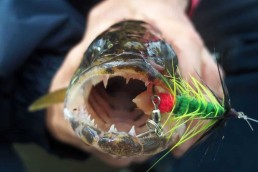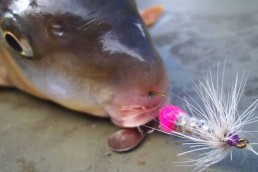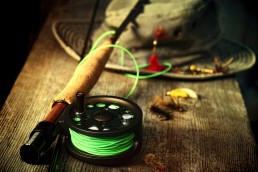The Tale and Tail of a Fishing Innovation that Entices ‘em All Part Two: The new Fly and its victims
SHARE THIS POST
“To fool a fish,” I’ve always said, “you’ve got to think like a fish.”
So designing a fly that would work on suckers and carp and other gamefish brought me back to watching hours of “Bobber” Anne’s underwater strike footage. There was one difference between the rough fish strikes and gamefish strikes: gamefish like bass were prone to opening their mouths prior to gathering in a lure in rapid fashion while suckers and carp would softly sneak up on the lure, pause, then slowly suck in a lure in an accordion-like snout movement. This act gradually brought the lure into the mouth cavity in jerky movements 1/4 of an inch at a time. No wonder they were able to detect the lure’s unnatural feel and weight. But all the time the Spin Bees were ingested the mouths of rough fish remained open, which allowed the lure to be blown out easily.
What style of fly would work best? I chose a wet fly design similar to the Timberwolf, a panfish fly hosting a bright tail egg sack, floss body and a Palmer-wound feather neck. On previous outings I‘d taken both suckers and carp on the Black and Red Timberwolf by accident.
With the fly’s design settled, a spinner was added to its rear end. Now we had the flash of a spinner for attraction and an open hook to attach a tiny piece of angleworm or the Anise-scented Red Ball egg. I felt scent was necessary to entice a full inhalation by a rough fish.
We first tested the new fly in June. The Mississippi River near home had lightened up enough to provide a fairly clear image on our underwater camera. We launched at the boat ramp below Rocking Chair pool. Several patterns of the new fly had been tied. Anne seemed especially interested in the yellow and pink patterns; I used the black and brown. All hosted a pink egg sack to give the fish a focus for a striking point.
While anchored with our camera gear down in a Benthic Zone, we set the stage: I had a fly rod and Anne had a spinning rod. Both of us had snapped on number 8 split shot 8 inches in front of our flies. When dropped, my fly was positioned directly downstream in front of the camera lens. The Flick Fly had come alive in a natural way, wavering and weaving its way down into the bottom Benthic Zone.
My brown fly with the egg attached went dead with its tail spinner hanging limp and simultaneously a little smallmouth hit. When the fish darted in, I noted a pair of redhorse suckers behind the eager little fish. I was unhooking my bass when Anne made the announcement that a sucker was up on her yellow fly. Sure enough, there it was, sucking on her offer of the yellow spinner fly and its tiny tip of garden worm. This time there was no rejection of the lure. It was hooked a moment later as the sucker turned sideways to retreat back to its staging position.
It was our first redhorse on the new Flick Fly, and would go into the livewell to be made into fish patties.
That summer day back in 2015 saw the two of us land, release and/or keep 14 suckers and two carp. We had succeeded in designing a technique to catch these elusive rough fish, and we were continuously harassed by smallmouths, walleyes and rock bass during our tests. I didn’t keep count on these; there were just too many. We had caught many smallmouths, walleyes, rock bass and pumpkinseeds.
Are you enjoying this post?
You can be among the first to get the latest info on where to go, what to use and how to use it!
We also learned a great deal about the new creation during this day and the days to follow. We weren’t always successful in setting the fly hook at the soft strike of a carp or sucker as we missed about 20 percent of the suck-in strikes. But the average number of hook-ups grew as the testing days progressed. It takes an alert sense of feel on a rod to determine when the hook-set should be applied—a high modulus graphite rod will help, but once you feel a faint tap you should count 1, then 2, and then set your hook on the next tap. First, you must get your fly offering down near the bottom, at times right on the floor, to attract rough fish. We only hooked up about 10 times on carp and suckers above the zones. It seems these two species held tight to the bottom in the Benthic Zones. The ones that we did hook above these locations must have been extremely hungry to seek out our insect imitator in the main river current.
We have these strikes on video thanks to Anne’s skill with underwater gear, and such occurrences are rare. We found that rough fish held hard to the bottom in the Benthic Zone, where food like snails, hellgrammites, crawfish, dead minnows and fly larvae are plentiful. This occurs in rivers. And remember, a rough fish’s mouth points toward the bottom like a vacuum cleaner.
What about lakes and reservoirs and the research we performed to prove the new fly was effective in structure when we worked walleyes?
Our new tail-spinnered fly had easily taken river walleyes—at times they had just become a nuisance. Suckers and carp were more leery while walleyes came in on the Fly without hesitation and gobbled it up. But in lakes we discovered that with extreme slow trolling the fly worked just off the bottom with spinning gear to best create an interest for the walleyes. Six to 12 inches off the bottom would rarely entice walleye strikes. That wasn’t true for the rivers. Though walleyes preferred the Benthic Zones, they’d often attack the fly 30 inches off the bottom in the main river current.
On a trip to a favorite walleye lake in Minnesota, the underwater cameras showed walleyes had a tendency to follow the Flick Fly great distances. Thirty feet seemed to be a general distance to follow before striking. However, if scent were added to the Fly, most would engage the bait in half that distance. Such evidence proves to us that scent tips were an enormous benefit in creating strikes. Our scenting devices were a Red Ball Egg or 3/8 inch of garden worm. Don’t use nightcrawlers, as they can kill the action of a spinner.
On lakes and reservoirs, a number of tests were done. We used straight crankbaits trolled beside a fly. Every time a school of walleyes was encountered, fish would peel off and follow the tail-spinnered fly, leaving the crankbait to go it alone. Obtaining a strike in these cases was dramatically increased if the fly was tipped with scent, at an estimated 45 percent or more. One time while working Mille Lacs Lake in Minnesota we had three walleyes, four perch and a single cisco all following a worm-tipped Fly at once—the 3-pound walleye had won out.
We tried the Flick behind a Bait Walker rig to gain depth in the water system, at 30 feet or so. One of the problems was dropback line length. We tried everything from 2 to 6 feet. In the end, 30 inches worked best. If you are a bait-and-sinker troller, 30 inches is recommended.
With all the trolling researched, I then settled on drifting the Fly off the bottom in lakes and reservoirs as the best way to present this lure. Here, we increased the weight from one number 5 split shot to two number 5 split shot pinched on the line 15 inches ahead of the fly. The drifting had to be done at an extremely slow rate. During such presentations for walleyes, several Flick Flys were dropped to the bottom. There, they would wiggle until they were lifted again and moved. As we viewed this action on video, it didn’t seem to bother the walleyes. When the Fly stopped on the bottom, the following walleyes just hung around eyeing the lure until it started to drift again. However, the Fly had to be moving off the bottom to see them strike it.
In part three next month, “Bobber” Anne and I will continue the research we’ve done on our new fly/lure. We’ll explain how trout, steelhead, pike, muskies and bass are taken with the new lure.
MWO
SHARE THIS POST
Did you enjoy this post?
You can be among the first to get the latest info on where to go, what to use and how to use it!
Dan Gapen
Considered one of the world’s leading river anglers, Dan Gapen, Sr. has shared his knowledge with MidWest Outdoors readers and viewers for more than 40 years. He is a member of all three Fishing Halls of Fame—International, National Freshwater, and Minnesota. He has an immense grasp of the world’s fisheries. He may be contacted at 877-623-2099.
@TheGapenCompany.



